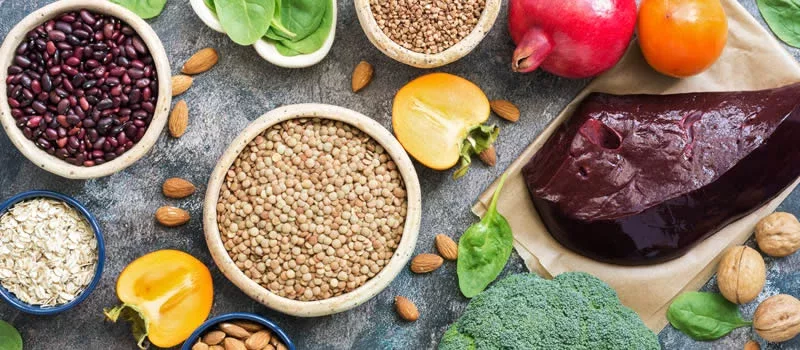
Tips to top up your iron intake
In this article
What is iron?
It’s a vital part of hundreds of proteins and enzymes needed for your body to function.
In your body, almost two-thirds of your iron is found in your blood, with the rest being stored throughout the body waiting to be used by the muscles and other enzymes.
Why is iron important?
Iron is essential for many important bodily functions including:
- Oxygen transport —Iron is necessary for the formation of two molecules: hemoglobin which transports oxygen to the body’s tissues and myoglobin which is involved in the transport and short‐term storage of oxygen in muscle cells.
- Energy production —Iron is needed for the activation of a key enzyme involved in energy production.
- Brain and nerve function —Iron is an essential co-factor in the synthesis of brain chemicals such as dopamine, norepinephrine and serotonin.
- Immunity —Iron is required for several immune functions
- Cell proliferation and DNA — Iron is essential for the group of enzymes involved in cell proliferation and DNA repair
What can cause low iron?
Iron absorption issues
The amount of iron you absorb from food is typically low, ranging from 5-25% depending on circumstance and the type of iron being eaten. So making sure you eat enough iron-rich foods in your diet is important to help maintain healthy iron levels.
Absorption of iron depends on many factors, but it starts in the small intestine and is influenced by the pH of the stomach.
High iron vs low iron foods
The type of iron you eat can also have an impact on your iron levels. There are two types of iron in foods:
- Heme iron — Heme iron is highly bioavailable (15%-35%) and dietary factors have little effect on its absorption. Sources include meat, poultry and fish.
- Non-heme iron — Non-heme iron absorption is lower than heme iron (2%-20%). The absorption of non-heme iron is strongly influenced by the presence of other foods. Sources of non-heme iron include cereals, pulses, legumes, fruits and vegetables.
Iron enhancers vs Iron inhibitors
Some foods inhibit the absorption of iron from your diet, while others enhance the absorption:
- Iron inhibitors — Inhibitors of iron absorption include phytic acid from grains, polyphenols commonly found in black tea, calcium, proteins from milk products and soy proteins.
- Iron enhancers — Enhancers of iron absorption are ascorbic acid and meat, fish and poultry when added to a high non-heme meal. Ascorbic acid will overcome the negative effect on iron absorption of inhibitors.
Who may need to consider more iron intake?
- Children and Adolescents — Iron is needed during periods of rapid growth. Children and adolescents benefit from an iron-rich diet.
- Women of reproductive age — Blood loss from heavy menstrual periods can impact iron levels.
- Vegetarians and vegans — Plant sources of iron are generally not as well absorbed as animal sources. Adding some vitamin C and avoiding inhibitors of iron absorption at mealtimes will help absorption.
- Athletes in training — Intense exercise can cause a loss of iron.
- High cow’s milk diet — Cow’s milk has been shown to inhibit iron absorption.
- Medications — Several medications can cause issues with iron. Speak to your healthcare professional about your medications and their interaction with iron.
How can you find out if you have healthy iron levels?
Iron levels can be determined by a detailed case history and a blood test. If you are concerned, please discuss it with your doctor.
Increasing iron-rich foods in your diet while reducing diet or lifestyle factors that could inhibit iron absorption can be beneficial. Iron supplementation may be recommended. Speak to your healthcare practitioner to see if supplementation is right for you.